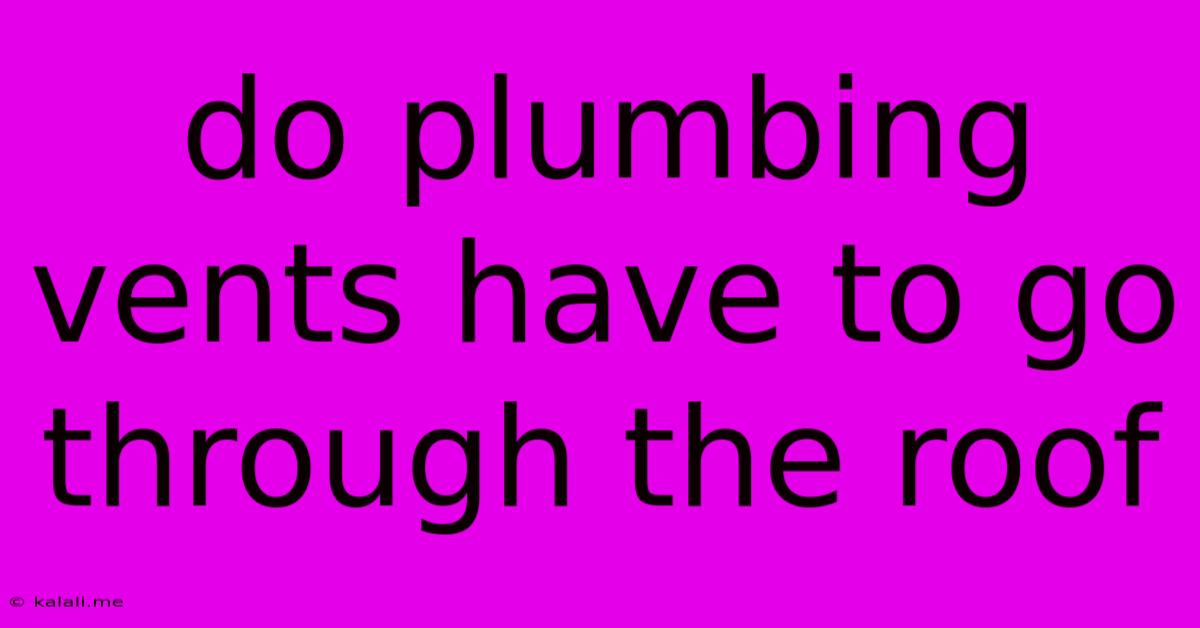Do Plumbing Vents Have To Go Through The Roof
Kalali
Jun 07, 2025 · 3 min read

Table of Contents
Do Plumbing Vents Have to Go Through the Roof? A Comprehensive Guide
Meta Description: Understanding plumbing vent requirements is crucial for proper home plumbing. This guide clarifies whether vents must go through the roof, exploring exceptions, benefits, and potential issues. Learn about vent types, placement, and code compliance.
Proper plumbing ventilation is essential for a functioning and safe drainage system. A common question among homeowners and DIY enthusiasts is whether plumbing vents absolutely have to penetrate the roof. The short answer is: generally, yes, but there are exceptions and important nuances to consider. This article will delve into the reasons why roof vents are typically necessary, the situations where alternative venting methods might be permissible, and the potential consequences of improper ventilation.
Why Roof Vents Are Usually Required
Plumbing vents are crucial for maintaining proper air pressure within your drainage system. Without adequate ventilation, several problems can arise:
- Siphoning: As water drains, the resulting vacuum can siphon water out of traps, leaving your home vulnerable to unpleasant sewer gases entering your living spaces. Traps, located under sinks and other fixtures, use water to create a seal that prevents these gases from escaping. Proper venting prevents the siphon effect from emptying these critical traps.
- Slow Drainage: Blocked air pressure can significantly impede the flow of wastewater through your pipes, leading to slow drains and potential backups.
- Gurgling Sounds: Characteristic gurgling noises from your drains are often indicative of insufficient venting, signaling that the system is struggling to handle waste effectively.
- Sewer Gas Odors: The most obvious and unpleasant consequence of poor ventilation is the release of noxious sewer gases into your home, posing potential health risks.
These problems highlight the critical role roof vents play in safeguarding your home's plumbing system. They allow air to enter the drainage system, equalizing pressure and ensuring efficient waste removal.
Exceptions and Alternative Venting Methods
While roof penetration is the most common and often preferred method, there are instances where alternative venting solutions might be considered. These are usually subject to stringent building codes and require the expertise of a qualified plumber:
- Air Admittance Valves (AAVs): These devices are sometimes used as a supplementary venting solution or in situations where roof venting is impractical. AAVs allow air to enter the system when necessary, but they are not a complete replacement for traditional venting in most cases. They are often limited in their capacity and may not be suitable for large or complex plumbing systems.
- Indirect Venting: This involves connecting vents from multiple fixtures to a central vent stack, which may then be vented through the roof or potentially through a wall, depending on local codes and system design. This requires careful planning and adherence to strict regulations.
It's imperative to consult local building codes and obtain permits before implementing any alternative venting methods. Incorrect venting can lead to serious plumbing issues and potentially void home insurance.
Choosing the Right Vent Type and Placement
There are several types of plumbing vents, each designed to fulfill specific needs. The choice of vent type and its placement should always align with local building codes and the specific requirements of your plumbing system. A qualified plumber can advise on the optimal approach for your home.
Common vent types include:
- Individual vents: These vent each fixture separately.
- Vent stacks: These serve multiple fixtures and are often the preferred method for larger systems.
Conclusion
While various venting methods exist, for most residential plumbing systems, venting through the roof remains the most reliable and effective solution. It guarantees proper air circulation within the drainage system, preventing siphoning, slow drainage, and the release of harmful sewer gases. Always prioritize compliance with local building codes and seek professional assistance from a licensed plumber to ensure your plumbing system is properly vented and functioning safely.
Latest Posts
Latest Posts
-
How Fast Can A Glider Rise In A Thermal
Jun 08, 2025
-
How To Field Dress A Turkey
Jun 08, 2025
-
Why Is My Toilet Draining But Not Flushing
Jun 08, 2025
-
Let The Dead Bury The Dead Meaning
Jun 08, 2025
-
Why Do Busses Stop At Railroad Tracks
Jun 08, 2025
Related Post
Thank you for visiting our website which covers about Do Plumbing Vents Have To Go Through The Roof . We hope the information provided has been useful to you. Feel free to contact us if you have any questions or need further assistance. See you next time and don't miss to bookmark.